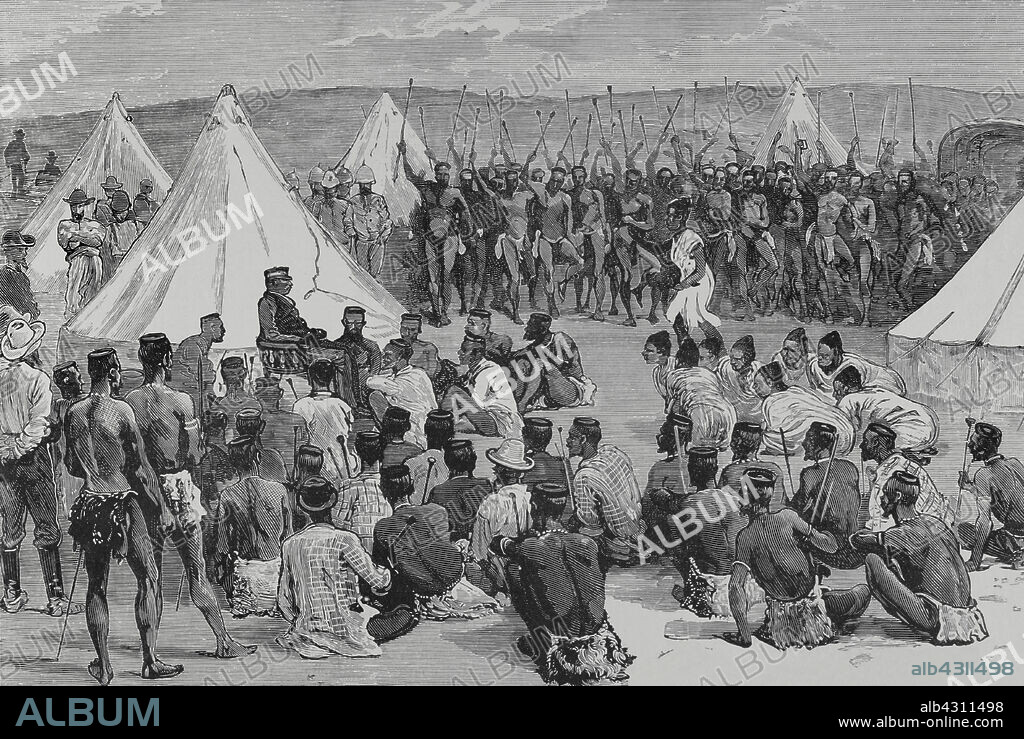alb4311498
Cetshwayo (Cetshwayo kaMpande) (c. 1826-1884). King of the Zulus (1872-1879). Restoration of King Cetewayo. Return of the king to his former territories after his captivity in England, following his capture by the British at the Battle of Ulundi (July 4, 1879), and his subsequent exile to Cape Town. In July 1882, Cetewayo was authorized to travel to the United Kingdom to seek support from British politicians for the restoration of the Zulu monarchy. Queen Victoria allowed him to return to Ulundi in January 1883, to rule a part of his former kingdom, without being able to have an army and with the obligation to cede part of his territory to another Zulu. The day after the installation of Cetewayo in Intonyanene, about fifteen miles from Ulundi, numerous deputations of the interior of the kingdom appeared in the camp, for the accomplishment of the ceremony that the natives called Indaba. It was the recognition and congratulation as loyal subjects. Cetshwayo, dressed in British style and seated in a wide armchair, attending the tributes with great seriousness. Dances were improvised in honor of the sovereign. Ceremony called "Indaba", congratulation of the subjects to the monarch at Intonyanene. King Cetewayo receiving a deputation of his relatives at Intonyanene. Engraving. La Ilustración Española y Americana (The Spanish and American Illustration), 1883.

|
Add to another lightbox |
|
Add to another lightbox |



Buy this image.
Select the use:

Caption:
Cetshwayo (Cetshwayo kaMpande) (c. 1826-1884). King of the Zulus (1872-1879). Restoration of King Cetewayo. Return of the king to his former territories after his captivity in England, following his capture by the British at the Battle of Ulundi (July 4, 1879), and his subsequent exile to Cape Town. In July 1882, Cetewayo was authorized to travel to the United Kingdom to seek support from British politicians for the restoration of the Zulu monarchy. Queen Victoria allowed him to return to Ulundi in January 1883, to rule a part of his former kingdom, without being able to have an army and with the obligation to cede part of his territory to another Zulu. The day after the installation of Cetewayo in Intonyanene, about fifteen miles from Ulundi, numerous deputations of the interior of the kingdom appeared in the camp, for the accomplishment of the ceremony that the natives called Indaba. It was the recognition and congratulation as loyal subjects. Cetshwayo, dressed in British style and seated in a wide armchair, attending the tributes with great seriousness. Dances were improvised in honor of the sovereign. Ceremony called "Indaba", congratulation of the subjects to the monarch at Intonyanene. King Cetewayo receiving a deputation of his relatives at Intonyanene. Engraving. La Ilustración Española y Americana (The Spanish and American Illustration), 1883.
Personalities:
Location:
PRIVATE COLLECTION
Credit:
Album / Prisma
Releases:
Image size:
4488 x 3007 px | 38.6 MB
Print size:
38.0 x 25.5 cm | 15.0 x 10.0 in (300 dpi)
Keywords:
1883 • AFRICA • AFRICAN CONTINENT • AFRICAN • AFRICANS • ARMCHAIR • ARMCHAIRS • ASSEMBLY • BAILAR • BOUTIQUE • BRITISH COLONIALISM • BRITISH IMPERIALISM • CAMP • CELEBRATION • CEREMONIAL ACT • CEREMONIES • CEREMONY • CETAWAYO • CETEWAYO • CETSHWAYO KAMPANDE • CETSHWAYO • CETYWAJO • CHAIR WITH ARMRESTS • COLONIALISM • COMMERCE • CONFERENCE • CONGRATULATION • COUNCIL • DANCE • DANCES • DANCING • DANSE • DISCUSSION • EASY CHAIR • ECONOMY • ENCAMPMENT • ENCOUNTER • ETHNIA • ETHNIC GROUP • ETHNICITIES • ETHNICITY • FAITHFULNESS • FEAST • FEASTS • FEMALES • FEST • FESTIVAL • FESTIVALS • FESTIVE EVENT • FESTIVITY • FETE • FIDELITY • FORTRESS • GATHERING • GREET • GREETING • IMPERIALISM • INDABA • INDÍGENA • INDIGENAS • INDIGÈNE • INDIGENOUS PEOPLE • INDIGENOUS • INTONYANENE • KETCHWAYO • KING • KWAZULU-NATAL • LOYALTY • MALES • MAN MEN • MAN • MEETING AGAIN • MEETING • MEN • MONARCH • MONARCHY • MUJER • MUJERES • NATIVE PEOPLE • NATIVE • NATIVES • PARTY • PRIVATE COLLECTION • RECEPTION • RESTAURATION • RESTORATION • RESTORING • RETURN • RÉUNION • RITE • RITUAL • RITUAL?? • RULER (POLITICAL) • RULERS • RUNNING THE GAUNTLET • SALUTE • SEATED • SESSION • SHOP • SHOPPING • SIT DOWN • SIT • SITS • SITTING • SOUTH AFRICA • SOUTH AFRICAN • SOUTH AFRICANS • SOUTH OF AFRICA • SOUTHERN AFRICA • SOVEREIGN (RULER) • SOVEREIGN • STAND • STORE • SUBDITOS • SUBJECT (CITIZEN) • SUBJECT • SUBJECTION • SUBJECTS • SUBMISSION • SUPPORT • SUPPORTERS • TENT • TENTS • TRADE • TRADING • ULUNDI • USUTHU • WAVING • WELCOME • WELCOMING • WOMAN WOMEN • WOMAN'S • WOMAN • WOMAN. • WOMANS • WOMEN'S • WOMEN • WOMENS • ZIBHEBHU • ZULU EMPIRE • ZULU KINGDOM • ZULU PEOPLE • ZULU • ZULULAND • ZULULANDIA • ZULUS
 Pinterest
Pinterest Twitter
Twitter Facebook
Facebook Copy link
Copy link Email
Email
